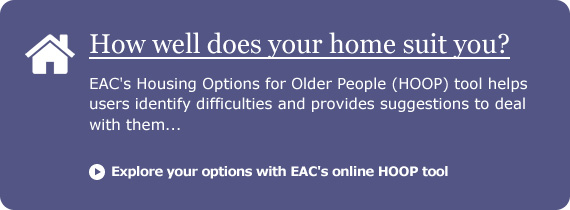Retirement & sheltered housing
Sheltered, retirement or warden-assisted housing are all terms used to describe accommodation provided specifically for older people. Developments may be blocks of flats or grouped bungalows, and are often referred to as ‘schemes’.
Schemes usually have the services of a Scheme Manager (formerly a ‘warden’), to manage the scheme and to offer support to residents who need it. She or he may be on site full-time in larger schemes, but usually only part-time in smaller ones. Sometimes the Manager role is played by a team, one of whom will visit as the need arises. Each property will have a careline alarm to summon help in an emergency.
Facilities
Retirement housing is usually designed with good levels of heating, and increasingly with doorways wide enough for walking frames and wheelchairs. Most schemes have a common room for social activities and many also have a garden, guest suite, car parking, buggy storage and perhaps a laundry room.
Independence
Retirement and sheltered housing provide privacy and independence, but with the reassurance of knowing help can be summoned if necessary, and the possibility of socialising with other people who are retired. Some providers now brand it as ‘Independent Living’.
To rent or to buy, or to part-buy
Sheltered housing can be either rented or purchased on a leasehold basis, and a small number of schemes offer shared ownership (part buy) options. Retirement housing to rent is usually provided by local councils and housing associations (social landlords), but as there is often greater demand than availability, there are likely to be allocation criteria and waiting lists. Often home owners and those in a position to buy may be given a lower priority than those who do not have this option.
However in recent years we are beginning to see more private provision for rent, which provides an opportunity for older people who might choose to rent when they move, to do so.
There is now a wider range of both purchase prices and monthly rents on offer. For purchasers, costs vary enormously between schemes. Leaving aside significant regional variations, the most reliable predictor of cost bracket is the age of a scheme. The average asking price for a new flat is around £270k (1 bed) or £360 (2 bed), whilst re-sales of pre-2010 properties average £120k (1 bed) or £150k (2 bed).
For renters, the variation of note is that between largely older social sector provision and predominantly newer private provision. The all-in (rent + service charge) cost for an older studio or one bedroom social rent flat is usually between £450 and £600 pcm, depending on location and landlord. This compares to £750 – £950 pcm for an older private flat, and upwards of £1,200 pcm for a private new build. For would-be renters on limited incomes, much of the newer provision may feel beyond their reach.
Factsheets on sheltered housing
- Housing and care options for older people (EAC Advice)
- Housing Options in Later Life (Independent Age)
- Buying a retirement property (EAC Advice)

